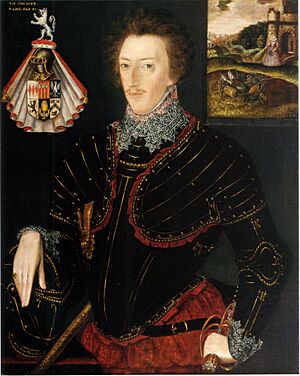Edward Hoby facts for kids
Sir Edward Hoby (born 1560, died 1617) was an important English person. He worked as a diplomat, a Member of Parliament, a scholar, and a soldier. He lived during the reigns of Queen Elizabeth I and King James I.
Edward Hoby came from a well-known family. His uncle was Lord Burghley, a very powerful advisor to Queen Elizabeth. He was also related by marriage to Queen Elizabeth's cousin. King James I liked him a lot. Hoby wrote several books supporting the Protestant religion. He also translated books from French and Spanish. His son, Peregrine Hoby, inherited his property.
Contents
Sir Edward's Early Life
Edward Hoby was born in 1560 at Bisham Abbey in Berkshire. He was the oldest son of Sir Thomas Hoby and Elizabeth Cooke. He went to Eton College, a famous school, where he became good friends with Sir John Harington. He also studied at Trinity College, Oxford.
His uncle, Lord Burghley, helped him get a good position at Queen Elizabeth's court. Hoby often went on secret missions for the Queen. His standing grew even more when he married Margaret Carey in 1582. She was the daughter of Henry Carey, 1st Baron Hunsdon, who was Queen Elizabeth's cousin. The day after his wedding, the Queen made him a knight.
Working for the Queen and King
In 1584, Sir Edward went with his father-in-law to Scotland on a special trip. He was very friendly and smart, and King James VI (who later became King James I of England) was very impressed by him. King James even wrote a letter saying he wanted Hoby to stay in Scotland. This made Queen Elizabeth unhappy, so Hoby pretended to be sick for a while to avoid court.
Hoby in Parliament
In 1586, he became a Member of Parliament for Queenborough, Kent. He was known as a good speaker in Parliament. In 1588, he was chosen to tell the Queen about the plans to defend England against the Spanish Armada. Later that year, he was elected to Parliament for Berkshire.
He became a justice of the peace for Middlesex in 1591. In 1592, he was elected for Kent. In 1594, he received a special right to buy and sell wool in England for ten years. This right was confirmed when King James I became king.
Later Career and Royal Favor
Sir Edward went with the Earl of Essex on a trip to Cádiz in 1596. In 1597, he became the constable of Queenborough Castle in Kent. He also received a job to find and prosecute people who were illegally exporting iron from England. He got to keep half of the money from these fines.
He represented Rochester in Parliament several times between 1597 and 1614. When King James I became king, he made Hoby a Gentleman of the Privy Chamber. The King also forgave Hoby's debts and gave him a special right to buy wool in Warwickshire and Staffordshire. Sir Edward often hosted the King at his home in Bisham.
His first wife died in 1605. Later, he married Cicely Unton.
Death and Legacy
Sir Edward Hoby died in Queenborough Castle on March 1, 1617. He did not have any children with his wives. However, he raised his son, Peregrine Hoby, and made him his heir.
Sir Edward was a very good scholar himself. He was friends with many learned people, including William Camden, a famous historian. Camden praised Hoby's generosity and achievements. Hoby also gave a valuable book to the library at Trinity College, Oxford.
Hoby's Writings
Sir Edward was also interested in Protestant theology. He wrote books arguing with Catholic writers like Theophilus Higgons and John Floyd.
Some of his theological writings include:
- A Letter to Mr. T[heophilus] H[iggons] (1609): This was a reply to a book by Higgons.
- A Counter-snarle for Ishmael Rabshakeh (1613): This book was a response to a book by John Floyd.
- A Curry-combe for a сохе-combe (1615): He wrote this under a funny pen name, "Nick-Groome of the Hobie-Stable."
Hoby also translated important books. He translated Politique discourses on trueth and lying by Matthieu Coignet from French in 1586. In 1597, he translated Theorique and Practise of Warre by Bernardino de Mendoza from Spanish.
Images for kids





